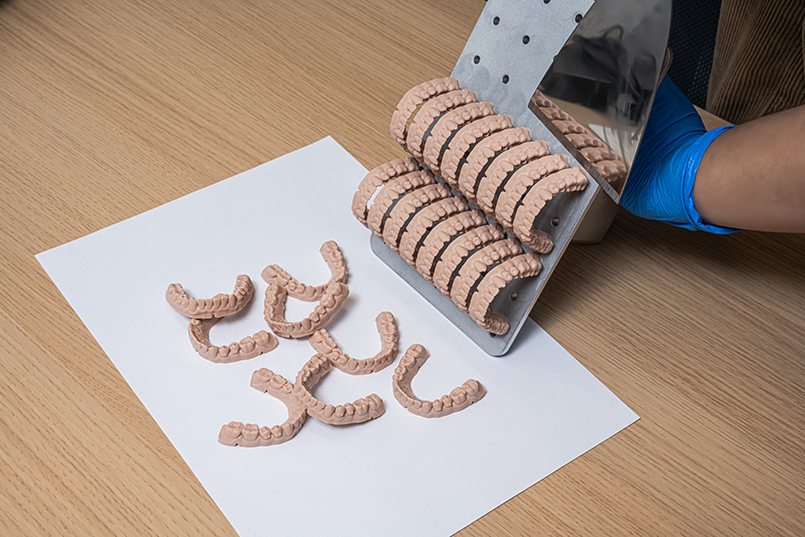According to statistics from the American College of Prosthodontists, more than 36 million Americans suffer from edentulism, having no remaining natural teeth. Dentures are the most common treatment for this form of tooth loss. Practitioners prescribe full dentures to 90% of toothless patients, and partial dentures to those with partial edentulism (i.e., several teeth are missing, but not all).
Creating full and partial dentures has traditionally been a time-consuming and labor-intensive process. Today’s 3D printing solutions provide a faster and more efficient way to produce dentures.
The conventional process for developing dentures requires a significant amount of hands-on work. Within a traditional laboratory workflow, a lab tech creates the prosthetic manually; attaching pontics, carving gum lines, applying/removing plaster, flasking the denture mold, and pressing it with acrylic—all by hand. Using dental scanning software and a 3D printer, prosthodontists eliminate many of the steps involved in conventional denture production.
Choosing a digital denture solution can reduce turnaround time and material costs. To determine which solution is best aligned to your practice, follow this guide on choosing the best 3D printer for dentures.

What to Look for In a Dental 3D Printer
3D printing dentures simplifies the manufacturing process. Dentists take digital oral impressions of the patient with an optical scanner. A technician imports the scans into a software program to create digital models for both the denture bases and the pontics before converting them into printable models. The tech prints the models, removes them from the build plate, and rinses off the resin, and removes the support structures before curing. Following curing, a quick polishing of the dentures and it is ready for use.
The digital denture production process requires more than an accurate 3D printer. Quality software and materials are also essential. To determine the best 3D printer for dentures, o a holistic view of the entire printing solution is needed.
Consider the following evaluation criteria:
Material Offering
A 3D printer works best with materials designed to work together. The strength and durability of 3D printable resins are constantly improving, but if your 3D printer is not compatible with the best materials, it can lead to suboptimal products. Operating a solution that isn’t compatible with third-party materials can also be complicated. Many users prefer to partner with suppliers in their own country to avoid international shipping and other complications.
Speed & Accuracy of the Printer
Speed and accuracy are examined when comparing printing solutions. Speed shows how quickly a printer can produce an appliance and is essential to determine potential daily output. Printing dentures requires a high level of accuracy, as they must properly fit the patient’s mouth. Application-specific software can improve the core speed and accuracy specs of a dental 3D printer.
Smooth Printing for Reduced Post Processing
Excessive post-processing can add hours to denture production. Some 3D printer models advertise impressive printing speeds, however, neglect to mention the amount of buffing and polishing required to make a product operational. 3D printers that can print at high speeds with smooth denture base surface reduce post-processing time and achieves the highest daily denture production numbers.
3D Printing Dental Solutions
3D printing vendors that are leading innovation in the dental industry are taking a solution approach – developing dental-specific solutions that encompass material, software, and machines. A solution approach is enabling leading additive manufacturing companies to 3D print clear aligners that require minimal post-processing – supporting same-day aligners. As advancements continue together across the three pillars – material, software, and machines, 3D printing will rapidly transform the dental industry.
The Benefits of 3D Printing Dentures:
Dentists that switch from conventional denture production to 3D printing experience a range of benefits, including:
- Cost-effective production: Dental resins are more affordable than traditional denture materials, such as acrylic, and 3D printing uses material more efficiently, reducing waste and saving money. Eliminating artisan and manual steps with conventional denture production and minimizing 3D post-processing steps significantly reduces labor, time, and overall production costs.
- Consistently accurate results: 3D-printed dentures are more accurate than those made with conventional processes. Digital denture production requires fewer steps and less manual labor than traditional methods, lowering the potential for variability – improving accuracy and quality.
- Agile remakes: Labs keep digital denture models on file after production. If the prosthetic doesn’t fit properly, they can easily make adjustments and fabricate a new denture quicker than traditional methods. Similarly, if a pair of dentures becomes damaged, a dentist can supply a replacement without repeating the entire production process.
- Versatile tool: Today’s 3D printing dental solutions do more than just create dentures. They can also produce night guards, retainers, crowns, bridges, clear aligners, dental models, and more.
How You Can Find the Best 3D Printer for Dentures
3D printing dental solutions enable dentists to streamline workflows for faster, more affordable denture production. However, finding the right solution requires careful evaluation. If you are looking for a 3D printer to fit into your operation, LuxCreo can help. We offer desktop 3D printing solutions for individual practices, as well as high throughput, industrial 3D printers to meet the needs of dental labs and multi-location dental groups. Contact us today to learn how you can incorporate our dental 3D printing solutions into your business..
To learn more about finding the best 3D printer for dentures, visit our contact page or call (650) 336-0888.
